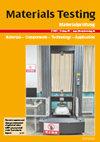Mechanical and thermal properties of short banana fiber reinforced polyoxymethylene composite materials dependent on alkali treatment
IF 2.4
4区 材料科学
Q2 MATERIALS SCIENCE, CHARACTERIZATION & TESTING
引用次数: 0
Abstract
The present study aimed to develop a recyclable composite material based on a natural product, namely banana fiber, instead of synthetic reinforcement elements such as glass fiber or carbon fiber in thermoplastic matrix composites employed in many aspects of daily life. Polyoxymethylene (POM) thermoplastic was used as the matrix material. 3 %, 6 %, and 9 % by weight short natural banana fiber was used as reinforcement. Furthermore, the study improved the mechanical and thermal properties of the composite material with chemical improvements based on alkali treatment of banana fiber. Banana fiber and POM was initially mixed mechanically and then extruded at temperatures between 170 and 190 °C to obtain a homogeneous mixture. The mixture obtained by extrusion was initially cooled in the cooling pool and then passed through the crusher to obtain granules. These granules were pressed in plastic injection molds to obtain standard test samples. The ratio of reinforcement material and the variations in mechanical and thermal properties of the composites induced by the alkali treatment are presented in figures and tables. Furthermore, the changes in cross-sectional material images were examined with electron microscopy scans. The tensile and flexural strength of the material improved with alkali treatment.取决于碱处理的短香蕉纤维增强聚甲醛复合材料的机械和热性能
本研究旨在开发一种基于天然产品(即香蕉纤维)的可回收复合材料,以替代日常生活中许多方面使用的热塑性基复合材料中的玻璃纤维或碳纤维等合成增强元素。使用聚甲醛(POM)热塑性塑料作为基体材料。以重量百分比为 3%、6% 和 9% 的短天然香蕉纤维作为增强材料。此外,该研究还通过对香蕉纤维进行碱处理来改善复合材料的机械性能和热性能。香蕉纤维和聚甲醛首先进行机械混合,然后在 170 至 190 °C 的温度下进行挤压,以获得均匀的混合物。挤压得到的混合物首先在冷却池中冷却,然后通过破碎机得到颗粒。这些颗粒在注塑模具中压制,得到标准测试样品。增强材料的比例以及碱处理引起的复合材料机械性能和热性能的变化见图和表。此外,还利用电子显微镜扫描检查了材料横截面图像的变化。经碱处理后,材料的拉伸强度和弯曲强度均有所提高。
本文章由计算机程序翻译,如有差异,请以英文原文为准。
求助全文
约1分钟内获得全文
求助全文
来源期刊

Materials Testing
工程技术-材料科学:表征与测试
CiteScore
4.20
自引率
36.00%
发文量
165
审稿时长
4-8 weeks
期刊介绍:
Materials Testing is a SCI-listed English language journal dealing with all aspects of material and component testing with a special focus on transfer between laboratory research into industrial application. The journal provides first-hand information on non-destructive, destructive, optical, physical and chemical test procedures. It contains exclusive articles which are peer-reviewed applying respectively high international quality criterions.
 求助内容:
求助内容: 应助结果提醒方式:
应助结果提醒方式:


